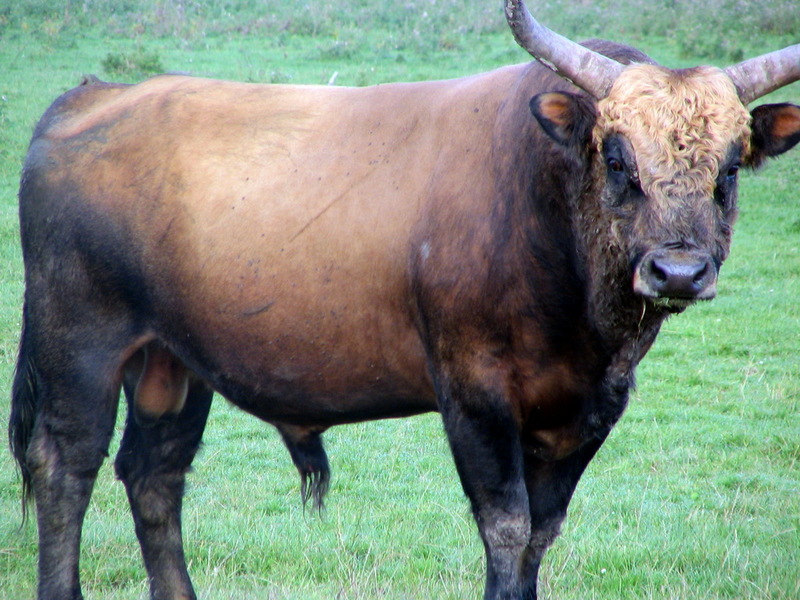Heck Cattle (Bos taurus) - wiki Heck cattle
From Wikipedia, the free encyclopedia
[Photo] Heck cattle bull by GerardM http://en.wikipedia.org/wiki/User:GerardM Date: 11:22, 17 Sep 2004 (UTC)
Heck Cattle, also called reconstructed aurochs, is a hardy breed of cattle (Bos taurus) often referred to by its promoters by the name of "aurochs". (The aurochs was an extinct recent ancestor to modern cattle.)
Development
Heck cattle were developed in the early 20th century by the Heck brothers in Germany in an attempt to breed back modern cattle to their presumed ancestral form, the Aurochs (Bos primigenius primigenius). Heinz Heck working at the Hellabrunn Zoological Gardens in Munich began creating the Heck breed about 1920. Lutz Heck, director of the Berlin Zoological Gardens, began extensive breeding programs supported by the Nazis during World War II to bring back the aurochs. The reconstructed aurochs fit into the Nazi propaganda drive to create an idyllic history of the Aryan nation.
Heinz Heck crossed Hungarian Grey Cattle, Scottish Highland, Brown, Murnau-Werdenfels, Angeln, German Friesian, Podolic and Corsican breeds. In Berlin, Lutz Heck crossed Spanish and French fighting cattle with other breeds. The resulting animals’ configurations were largely similar. The Berlin breed later was lost because of the hardships in the times after World War II and modern Heck cattle are descended only from the Hellabrunn breed. At the end of the 20th century, other so-called primitive breeds were crossbred with Heck cattle to come closer to the aim of creating a cattle breed that resembles the extinct aurochs in external appearance.
Characteristics
A typical Heck bull should be at least 1.6 m (5.25 ft) high and a cow 1.4 m (4.60 ft), with weight 600 to 900 kg (1,300 to 2,000 lb). Heck cattle are twenty to thirty centimeters shorter than the aurochs they were bred to resemble. However, cross-breeding efforts continue to increase the size and weight of the breed, particularly in Germany.
The Heck bulls were not much larger than the bull of most breeds of domestic cattle, while wild aurochs bulls are believed to have often exceeded 1000 kilograms (2,200 lb), half the size of a rhinoceros. So the African Watusi cattle were then brought into the herd. The result was a somewhat larger animal, but it also caused infertility among the cows, a signal of the genetic divergence that had occurred between these populations of Bos over the millennia. Heck cattle were first bred outside of a zoo in 1980. There were 88 registered at that time. Continued crossbreeding with these animals resolved the infertility in the cows.
Distribution
There are about 2000 Heck cattle in Europe and few elsewhere.
In Oostvaardersplassen in Flevoland near Lelystad (Netherlands), there are about 600 Heck cattle free roaming without human interference. Other cattle are at the Falkenthaler Rieselfelder near Berlin. There are also Heck Cattle at the Nesseaue nature reserve near Jena, Thuringia and at the Grubenfelder Leonie nature reseve in Auerbach, Bavaria. There were about 100 registered in France in 2000.
Controversy
Even though trying to bring back extinct species may seem commendable, "breeding back" is a controversial procedure in the scientific community (see also Quagga). The general consensus among biologists today is that the Hecks' original methodology used to "recreate" the aurochs was flawed: once a genetic lineage is gone, it cannot be "bred back". Some go as far as to consider it outright deceitful. For example, Professor Z. Pucek of the Bialowieza Nature Preserve has called the Heck cattle as the "biggest scientific swindle of the 20th Century". Professor Pucek has devoted his life to the conservation of the surviving native Wisent (European Bison) which is seen by some as competition to Heck cattle development.
On the other hand, Heck cattle are considered by many the most suitable cattle breed for low intensity grazing systems in certain types of nature reserves, due to their ruggedness and lack of need for human care. Heck cattle today are propagated in some places to fulfill the role of extinct megafauna in the ecosystem. However, there is uncertainty as to what ecological niche the aurochs itself filled. Dr Frans Vera claims that the aurochs lived in open parkland and supports their inclusion in nature reserve management. Cis van Vuure, however, in his book, Retracing the Aurochs: History, Morphology and Ecology of an Extinct Wild Ox suggests that the aurochs dwelled in dense forests and marshes while the Wisent dwelled in the open landscape. Wisent supporters claim that Heck cattle landscape management is a public relations ploy in order to illegitimately garner support for Heck cattle at the expense of a genuine native species, the Wisent.
Breed organizations
SIERDA ??? Syndicat International pour l’Elevage, la Reconnaissance et le D??veloppement de l’Aurochs-reconstitu?? (French: International Union for the Breeding, Reintroduction and Development of Heck Cattle)
http://en.wikipedia.org/wiki/Heck_cattle
| The text in this page is based on the copyrighted Wikipedia article shown in above URL. It is used under the GNU Free Documentation License. You may redistribute it, verbatim or modified, providing that you comply with the terms of the GFDL. |
